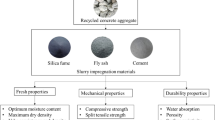Abstract
Roller Compacted Concrete Pavements (RCCP) are mostly designed by soil-compaction technique. However, the shortcomings associated with the soil-compaction method warrant a scientific way of designing RCCP mixtures based on the paste volume requirements considering the compactness and morphology of aggregates. To evaluate the optimum binder ratio (ratio of paste volume to the volume of void) for RCCP, several mixes were prepared following the particle packing approach by varying the binder ratio at a constant water-cement ratio (0.42). Fresh density, consistency, compactability, hardened density, and compressive strength were considered for binder ratio optimization. It was observed that there exists a linear relationship between the binder ratio and hardened properties up to a ratio of one; post this, a significant decrease in the considered hardened properties was observed. The results indicate that the RCCP mixtures could achieve higher strength and good workability with a binder ratio of 1.





Similar content being viewed by others
References
Williams S (2013) Comparison of the superpave gyratory and proctor compaction methods for the design of roller-compacted concrete pavements. Transp Res Rec 1557:106–112. https://doi.org/10.3141/2342-13
Selvam M, Debbarma S, Singh S, Shi X (2022) Utilization of alternative aggregates for roller compacted concrete pavements—a state-of-the-art review. Constr Build Mater 317:125838. https://doi.org/10.1016/j.conbuildmat.2021.125838
Selvam M, Singh S (2022) Material selection and mixture proportioning methods for sustainable roller-compacted concrete pavements. J Mater Civ Eng 34:3122002. https://doi.org/10.1061/(ASCE)MT.1943-5533.000432
Fakhri M, Saberik F (2016) The effect of waste rubber particles and silica fume on the mechanical properties of roller compacted concrete pavement. J Clean Prod 129:521–530. https://doi.org/10.1016/j.jclepro.2016.04.017
Harrington D, Abdo F, Adaska W, Hazaree C (2010) Guide for roller-compacted concrete pavements. Institute for Transp Iowa State University
Modarres A, Hosseini Z (2014) Mechanical properties of roller compacted concrete containing rice husk ash with original and recycled asphalt pavement material. Mater Des 64:227–236. https://doi.org/10.1016/j.matdes.2014.07.072
Mohammed BS, Adamu M (2018) Mechanical performance of roller compacted concrete pavement containing crumb rubber and nano silica. Constr Build Mater 159:234–251. https://doi.org/10.1016/j.conbuildmat.2017.10.098
Amer N, Delatte N, Storey C (2003) Using gyratory compaction to investigate density and mechanical properties of roller-compacted concrete. Transp Res Rec. https://doi.org/10.3141/1834-10
Fakhri M, Amoosoltani E, Aliha MRM (2017) Crack behavior analysis of roller compacted concrete mixtures containing reclaimed asphalt pavement and crumb rubber. Eng Fract Mech 180:43–59. https://doi.org/10.1016/j.engfracmech.2017.05.011
Fakhri M, Amoosoltani E (2017) The effect of reclaimed asphalt pavement and crumb rubber on mechanical properties of roller compacted concrete pavement. Constr Build Mater 137:470–484. https://doi.org/10.1016/j.conbuildmat.2017.01.136
Marchand J, Gagné R, Ouellet E, Lepage S (1997) Mixture proportioning of roller compacted concrete—a review. Concr Technol Spec Publ SP. https://doi.org/10.1016/j.tranpol.2008.12.012
Cetin A, Kaya Z, Cetin B, Aydilek AH (2014) Influence of laboratory compaction method on mechanical and hydraulic characteristics of unbound granular base materials. Road Mater Pavement Des 15:220–235. https://doi.org/10.1080/14680629.2013.869505
Dawson A (2014) Pavements Unbound: Proceedings of the 6th International Symposium on Pavements Unbound (UNBAR 6), 6–8 July 2004, Nottingham, England. CRC Press
Selvam M, Nssp K, Kannan KR, Singh S (2023) Assessing the effect of different compaction mechanisms on the internal structure of roller compacted concrete. Constr Build Mater 365:130072. https://doi.org/10.1016/j.conbuildmat.2022.130072
Selvam M, Singh S (2023) A review on influence of compaction mechanisms on RCCP performance. ACI Mater J. https://doi.org/10.14359/51737290
Sengun E, Alam B, Shabani R, Yaman IO (2019) The effects of compaction methods and mix parameters on the properties of roller compacted concrete mixtures. Constr Build Mater 228:116807. https://doi.org/10.1016/j.conbuildmat.2019.116807
Dessouky S, Masad E, Bayom F (2004) Prediction of hot mix asphalt stability using the superpave gyratory compactor. J Mater Civ Eng 16:578–587. https://doi.org/10.1061/(ASCE)0899-1561(2004)16
Gao L, Ni F, Charmot S, Luo H (2014) Influence on compaction of cold recycled mixes with emulsions using the superpave gyratory compaction. J Mater Civ Eng. https://doi.org/10.1061/(ASCE)MT.1943
Mallick RB (1999) Use of superpave gyratory compactor to characterize hot-mix asphalt. Transp Res Rec. https://doi.org/10.3141/1681-11
Mohammad Louay N, AL Shamsi K (2007) A look at the bailey method and locking point concept in superpave mixture design
Selvam M, Singh S (2023) Comparative investigation of laboratory and field compaction techniques for designing roller compacted concrete pavements (RCCP). Int J Pavement Eng 24:1–13. https://doi.org/10.1080/10298436.2023.2177850
Selvam M, Singh S (2023) Influence of compaction methods on the optimum moisture content and performance of roller compacted concrete pavements. J Mater Civ Eng. https://doi.org/10.1061/JMCEE7/MTENG-15680
Selvam M, Dane R, Singh S (2023) Systematic approach to optimize roller-compacted concrete pavements mixes through particle packing method. In: Conference of Transportation Research Group of India. Springer, pp 57–73
Acknowledgements
The first author would like to express his gratitude to the Ministry of Education, the Government of India, for providing the PMRF scholarship. Also, the authors wish to thank and acknowledge the funding received from the Indian Institute of Technology Madras, Chennai, under project no: SB20210809CEMHRD008100 (Technologies for Low carbon & Lean Construction (TLC).
Author information
Authors and Affiliations
Corresponding author
Ethics declarations
Conflict of Interest
The authors declare that they have no conflict of interest.
Additional information
Publisher's Note
Springer Nature remains neutral with regard to jurisdictional claims in published maps and institutional affiliations.
Rights and permissions
Springer Nature or its licensor (e.g. a society or other partner) holds exclusive rights to this article under a publishing agreement with the author(s) or other rightsholder(s); author self-archiving of the accepted manuscript version of this article is solely governed by the terms of such publishing agreement and applicable law.
About this article
Cite this article
Selvam, M., Singh, S. Optimal Paste Volume Method: An Alternative Mixture Proportioning Method for Roller Compacted Concrete Pavement. Transp. in Dev. Econ. 10, 8 (2024). https://doi.org/10.1007/s40890-023-00191-w
Received:
Accepted:
Published:
DOI: https://doi.org/10.1007/s40890-023-00191-w




